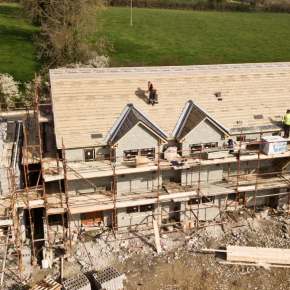
GUEST ARTICLE: Six important construction tips for building a smart home
There is no official definition of a smart home; it began more as a buzzword. A smart home can actually be any dwelling or commercial premises, be it a mansion, country cottage or studio apartment.
What makes it a ‘smart’ is that it is connected to digital technology that enhances living conditions. All smart homes look different because there is no set standard for how to make a home ‘smart’. Each smart build is tailor wired to the needs of the person or people living in it.
Here are six important construction tips for building a smart home.
1. Planning and Design
Before construction even begins on a new smart house, the entire system needs to be completely designed and approved well in advance. Once breaking ground, foundation work or laying out wire mesh (for more information on reinforcement mesh see Heaton Products) have commenced, it is too late to start planning a smart system. The system should have allowances for expansions and future builds both in physical and digital space. Retrofitting or expanding when allowances for expansion haven’t been made, is expensive, complicated and sometimes near impossible to do.
2. The Hub
The smart home hub is the brain of the smart home. It networks all the smart devices in the smart home, allowing them to talk to each other. From the hub, you are able to set your various smart devices to do what you want them to do. As a part of the construction process, this is the most important part of any smart home. If you are using a wired network, the hub needs to be properly wired so that the system is not exposed exteriorly to tampering or to water ingress. It should be located in a good central area because it has to be able to talk to all the other smart devices in the house. If a wireless system is going to be used for the hub then a repeater should be considered, especially in houses that have thick walls, walls that contain insulation or reinforcing as these can interrupt or weaken the signal.
3. Heating and cooling
Installing devices such as HVAC systems that allow you to optimise the temperature, humidity and airflow in your home not only allows for it to be a smart home but it can also improve energy efficiency. Smart vents can be installed to assist with the HVAC system and they do not take up more space than traditional vents do. New smart HVAC systems are installed to suit each home’s needs.
4. Smart flooring
Smart floorings are less about being wired to the smart home hub and more about being incredibly smart products. New tiling products have recently been released that are coated in new technology that allow them to be self-cleaning, air-purifying and anti-microbial which all helps prevent the build-up of mildew and mould. A very new product on the market is air-purifying hardwood flooring, which works with light exposure and air movement. The installation of smart flooring is no different from the installation of regular flooring.
5. Smart Lighting
Smart lighting can be approached in one of three ways; smart light bulbs, smart light switches and smart plugs or a combination of the three. Smart light bulbs are usually LEDs and should be used in single bulb lamps, accent lighting and other secondary lighting sources in the home because they require a constant power source in order for them to be accessed wirelessly. For primary room lighting, smart switches should be used. Smart switches are larger in size than ordinary switches and require more space in the wall when installed, however, installation is just as simple as installing an ordinary switch. Smart plugs plug into existing wall sockets allowing for remote control of lamps and secondary lighting fixtures.
6. Smart security
New smart door locks allow you to digitally lock and unlock your doors with the use of an app. Installing these new locks is as easy as installing regular locks to your door, however, some smart lock internal thumbturn plate mechanisms are larger than your ordinary lock and can take up quite a bit of space on the outside of your door. This needs to be considered if the door has a trim. Smart door locks also come with smart doorbells that have video cameras instead of the traditional peephole. The external housing of the doorbell with the video camera is significantly larger than your traditional doorbell. When installing the doorbell care must be taken to avoid all water ingress or tampering with the electrical system.
Smart homes are truly the future of home construction. Utilising modern technology such as this also can make homes a lot more energy-efficient, in a time when we all need to be doing our part for climate change. Smart homes are making life easier with remote access, voice control and apps to time lights and adjust the temperatures.
Bio
Martin Heaton is Owner and Director of Heaton Products, a Midlands-based manufacturer and supplier of building products, materials, and equipment to the construction industry. The home of Trestlemate, Propmate, Pull Up Mate, and Up-Rite, Heaton Products is an innovative leader in the development of products that help construction projects become safer, more economical, and more efficient.
Latest news

30th April 2025
Digital Construction Week announces seminar programme for its landmark 10th edition
Digital Construction Week (DCW) returns to ExCeL London on 4 – 5 June 2025 with its most impactful programme yet. It brings together the best and brightest from across AECO, for two days of practical learning and idea sharing.
Posted in Articles, Building Industry Events, Building Industry News, Building Products & Structures, Building Services, Building Systems, Exhibitions and Conferences, Information Technology, news, Restoration & Refurbishment, Retrofit & Renovation, Seminars
29th April 2025
Senior pledges to ‘bee’ part of the solution with new biodiversity initiative
Senior Architectural Systems has installed its first on-site beehive, marking another step forward in its commitment to sustainability and biodiversity.
Posted in Articles, Building Industry News, Building Products & Structures, Building Services, Curtain Walling, Doors, Glass, Glazing, Innovations & New Products, news, Restoration & Refurbishment, Retrofit & Renovation, Sustainability & Energy Efficiency, Walls, Windows
29th April 2025
West Fraser range delivering key benefits for South-East carpentry company
An experienced carpenter and building site manager who has recently set up his own company is using high performance panel products from the West Fraser range.
Posted in Articles, Building Industry News, Building Products & Structures, Building Systems, Case Studies, Garden, Restoration & Refurbishment, Retrofit & Renovation, Sustainability & Energy Efficiency, Timber Buildings and Timber Products
29th April 2025
CPD Courses Available Online From Ecological Building Systems
Ecological Building Systems, a leading supplier of natural building products for sustainable construction, has revealed its comprehensive CPD programme for the year ahead.
Posted in Articles, Building Industry Events, Building Industry News, Building Products & Structures, Building Services, Continuing Professional Development (CPD's), Information Technology, Innovations & New Products, Insulation, Restoration & Refurbishment, Retrofit & Renovation, Seminars, Sustainability & Energy Efficiency, Training, Walls, Waste Management & Recycling
 Sign up:
Sign up: